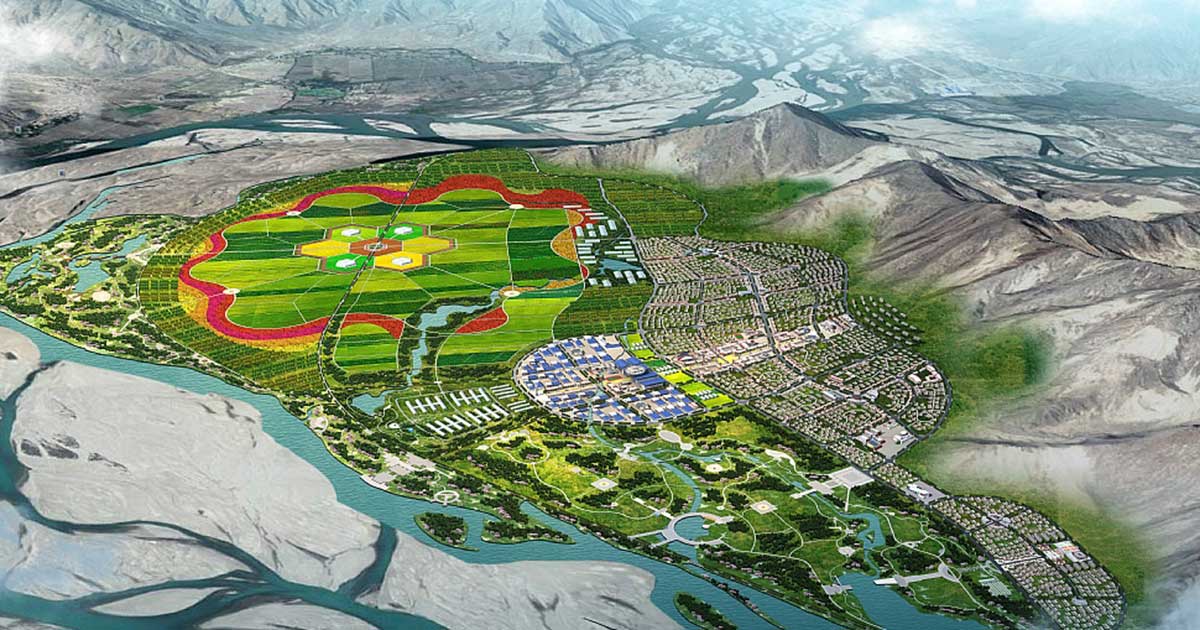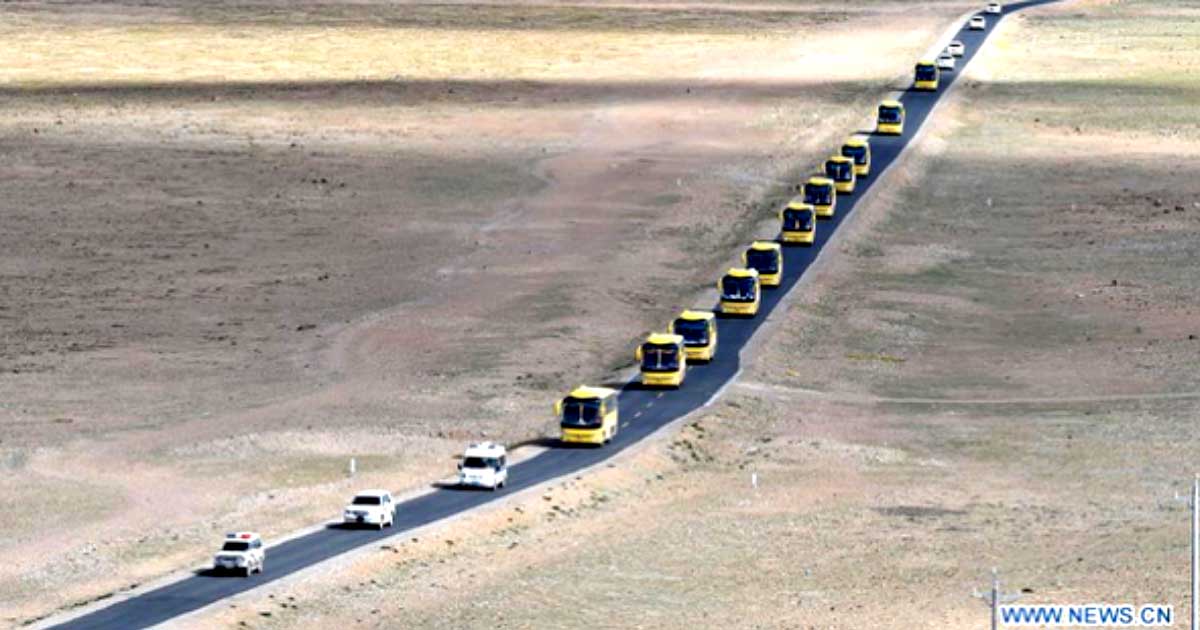More than 17,000 Tibetans from Tsonyi (Chinese: Shuanghu) county, Nagchu (Naqu) prefecture are to leave their homes to settle about 400km away in Lhoka (Shannan) prefecture of the “Tibet Autonomous Region,” Chinese state media are reporting. The Tibetans will join the 4,000 farmers and herdsmen that were already relocated in the first phase of relocation in 2019.[1]
According to state media outlet Xinhua, by August 2022, 17,555 people from Nagchu prefecture will be relocated to Sinburi (Senburi) Village, Gongkar (Gongga) County, Lhoka in southern Tibet, as part of a plan to relocate 26,304 people mostly from Tsonyi County, Amdo (Anduo) county and Nyima (Nima) county in Nagchu prefecture to Lhoka[2] prefecture within the TAR. The relocation plan in Lhoka is managed by the Lhoka government’s “Happy Home Construction Administration.”[3]
The International Campaign for Tibet is deeply concerned about the continuing reports of China’s relocation of Tibetans.
The organization said: “Given the climate of fear and repression in Tibet and the lack of any means for redress through an independent judiciary, such measures represent a drastic violation of the rights of Tibetans who are now vulnerable to poverty and marginalization. What happens in Nagchu county is nothing less than forced migration, with the lives of thousands of Tibetans upended. The international community should urge the Chinese government to stop these programs that serve to control the Tibetan people.”

Projected design of relocation site in Sinburi, Lhoka prefecture where 17,555 Tibetans will be relocated by August 2022.[4]
Bigger policy
The new measures are part of a bigger policy launched in 2018 by the Tibet Autonomous Region Communist Party Committee designed to relocate individuals living in very high-altitude regions throughout Tibet, defined as 4,800 meters high or above.[5] According to this “very high-altitude ecological relocation plan,”[6] 130,000 people from 20 counties and 97 townships from the autonomous prefectures of Shigatse (Rikaze), Nagchu and Ngari (Ali) in the TAR are to be relocated between 2018 and 2025.[7] More than 100,000 of the 130,000 Tibetans will be resettled along the Yarlung Tsangpo River,[8] with plans to develop a core economic zone with industrial corridors along the river.[9]
The first relocation site established in the 2018 plan was located in Gachong Village, Gurum (Gurong) township, Toelung Dechen (Duilong Deqing) District, Lhasa prefectural city. According to a Xinhua news report dated Oct. 24, 2020, 1,102 residents were relocated from Gurum Township from Jialing Jiadong Village, Rungma (Rongma) Township, Nima County in Nagchu prefecture in the Jangthang (Qiangtang) Nature Reserve area.[10] The International Campaign for Tibet reported on this relocation back in 2018 when Chinese government news sites first published images of busloads of Tibetans being relocated. At the time, Chinese government documents stated plans to complete the relocation of 130,000 Tibetans by 2020, rather than the current 2025 timeline.

Chinese state media featured this image of a motorcade of coaches carrying Tibetans being displaced from a township in the Jangthang nature reserve area to Tibet’s capital of Lhasa. Xinhua, June 20, 2018.
Pretext to achieve population control
It is notable that Chinese authorities have cited different policies or terms for relocation over time: “ecological migration,” “poverty alleviation” and in this case “very high-altitude ecological relocation,” implying that there is no coherent goal other than using these terms as a pretext to achieve population control. This “very high-altitude relocation plan” notably targets all individuals—nomads, herdsmen and farmers—regardless of whether they live in existing homes.
Tibetan nomads and herders have been relocated and are being relocated or banned from accessing grasslands without respecting the principles of free, prior and informed consent (known as FPIC). This has led to the forced relocation and settlement of almost 2 million Tibetan nomads, the loss of their livelihood, poverty and marginalization. The figures for Tibetans who are relocated who live in fixed homes remain unknown, but under the so-called poverty alleviation, ecological migration and now the very-high altitude ecological migration plans, more and more settled Tibetan lives are being uprooted and instantly altered to achieve central government plans to dilute Tibetan identity, surveil and control, and finally enforce their assimilation into the Chinese cultural and economic world.
Footnotes:
[1] Tibet.cn, 30 June 2022, ‘搬离极高海拔“生命禁区” 西藏2.6万人生态搬迁工作启动’ (‘The ecological relocation work of 26,000 people in Tibet has started’, http://www.tibet.cn/cn/index/news/202206/t20220630_7231318.html; The Paper, 27 August 2020, ‘西藏实施极高海拔地区贫困牧民生态搬迁—— 住进新房子,过上新生活’ ( Tibet implements ecological relocation of impoverished herdsmen in extremely high altitude areas – living in new houses and living a new life), https://www.thepaper.cn/newsDetail_forward_8904557.
[2] Government of the Tibetan Autonomous Region, 26 June 2022, ‘山南森布日安置点二期搬迁启动’ (The relocation of the second phase of the Senburi resettlement site in Shannan started’), http://www.xizang.gov.cn/xwzx_406/dsdt/202206/t20220626_304899.html
[3] Tibet Autonomous Region Tourism Development Department, 9 October 2020, ‘【走向我们的小康生活】西藏极高海拔移民迈向小康’ (‘【Towards Our Well-off Life】Tibetan High-altitude Immigrants Towards a Well-off Life’), http://lyfzt.xizang.gov.cn/xwzx_69/xzxw/202010/t20201009_178219.html.
[4] ‘山南市森布日高海拔地区生态搬迁安置区总体规划’ (‘Overall Planning of Ecological Relocation and Resettlement area in Senburi High altitude area of Shannan City’), 1 December 2018, Engineering Design and Research Institute of Sichuan University Co. Ltd., http://www.edriscu.com/info.asp?i=518.
[6] Xinhua net, 27 June 2022, ‘西藏启动1万余人生态搬迁项目’ (‘Tibet launches ecological relocation project for more than 10,000 people’), http://www.news.cn/local/2022-06/27/c_1128780052.htm.
[7] Tibet Ngari Regional Administrative Office, 19 March 2020, ‘西藏极高海拔生态搬迁破解人与自然共生难题’ (‘High-altitude ecological relocation in Tibet solves the problem of symbiosis between man and nature’), https://www.al.gov.cn/info/1034/25899.htm.
[9] Shannan Prefecture Happy Home Construction Administration, 31 December 2019, ‘幸福家园建设管理局简介’ (‘Introduction of Happy Home Construction Administration’), http://xfjyj.shannan.gov.cn/zwgk/dwjj/201910/t20191022_46280.html.
[10] ‘搬出“无人区”,产业连成串——西藏极高海拔生态搬迁点的新生活’ (Moving out of the “no-man’s land”, the industry is in a series – a new life in the ecological relocation site of extremely high altitude in Tibet’), 24 October 2020, Xinhuanet, http://www.xinhuanet.com/politics/2020-10/24/c_1126652650.htm

